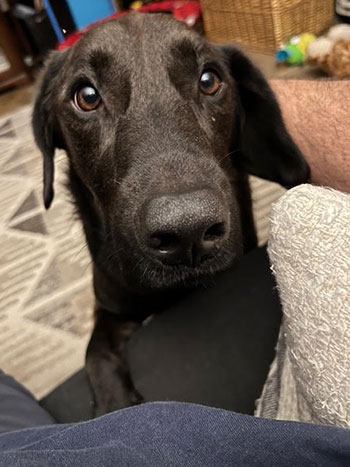Key Takeaways
- At only two-years old, Walter, a chocolate Labrador, was diagnosed with Addison’s Disease, an endocrine system disorder.
- The condition can be fatal if not treated right away.
- Walter’s pet parents took him to the vet, and they were able to stabilize him, but he almost didn’t make it.
- Long-term treatment of Addison’s disease in dogs primarily consists of hormone replacement therapy. Walter is on a drug regimen and is living a normal life.
Table of Contents
Diagnosis: Addison’s disease
Cost: $13,577 | Healthy Paws reimbursed: $10,111
Coverage options: 80 percent reimbursement | $250 deductible
Walter is a four-year-old chocolate Labrador typical of his breed – smart, active, people-loving, and a quick learner with training.
“He is so playful and great with our kids. We have a three-year-old son, and he and Walter are buddies. He loves to go on walks and out in public, like to Home Depot and the mall,” said Jeffrey, his pet parent.
Walter becomes lethargic, won’t eat
When Walter was only two years old, he started throwing up and wouldn’t eat, even chicken and rice. He lost 10 pounds in a week and was acting lethargic and not himself. After a couple of days, they took him to urgent care, where they ran several tests.
The testing indicated that Walter had Addison’s disease, an endocrine system disorder caused by a hormonal imbalance. It’s a grave condition that can be fatal if not treated. Walter was admitted to the hospital for monitoring for several days. Dogs with Addison’s can experience episodes known as an Addisonian crisis, during which they may experience cardiac arrhythmias. This happened with Walter, and the veterinarian didn’t know if he’d pull through.
“At one point, the doctor called us and said to come make a decision (whether to euthanize). Then he said, ‘Give me one more chance.’” Jeffrey said.
Emergency treatment for Addison’s disease in dogs involves stabilizing the animal through rehydration, cortisol-replacement medications, and other drugs to counteract the effects of hyperkalemia (excessive potassium). The vet wanted to double the dosage and the time the IV was inserted. It worked, and Walter emerged from the episode. Testing indicated his cortisol levels were normal, and he was eating and walking outside.
“We got a call in the morning that he was doing much better; he was active and acting more like a lab should act. They called us that afternoon and said to come pick him up.”
How Walter is doing today
Long-term treatment of Addison’s disease in dogs primarily consists of hormone replacement therapy. Walter takes a once-a-month injection of enzymes and minerals that his adrenal gland no longer produces and a daily dose of prednisone, a steroid. With this treatment, he doesn’t show any signs of sickness.
“He is a normal chocolate lab. People see him, and they don’t know he has Addison’s. He is living a normal, happy life,” Jeffery said.
How Healthy Paws helped
Jeffrey had signed Walter up for a Healthy Paws insurance plan as soon as he adopted him after spending thousands of dollars in vet bills for a German shepherd dog that is also part of their family.
He was pleased when Healthy Paws paid 80 percent of the cost of diagnostics, hospitalization, and initial treatment for Addison’s, which totaled $7,061. He also is reimbursed for Walter’s ongoing daily and monthly treatments.
“Healthy Paws pays for what they cover every month and in a timely manner. We will be getting another dog soon and will have that insured also. We are very happy with Healthy Paws and have been referring our friends to them also,” he said. “Walter was the first dog we signed up, but now as long as we have dogs, they will be insured.”
The claim scenarios described here are intended to show the types of situations that may result in claims. These scenarios should not be compared to any other claim. Whether or to what extent a particular loss is covered depends on the facts and circumstances of the loss, the terms and conditions of the policy as issued, and applicable law.
Insured persons providing testimonials in this report have not received compensation for their statements.








